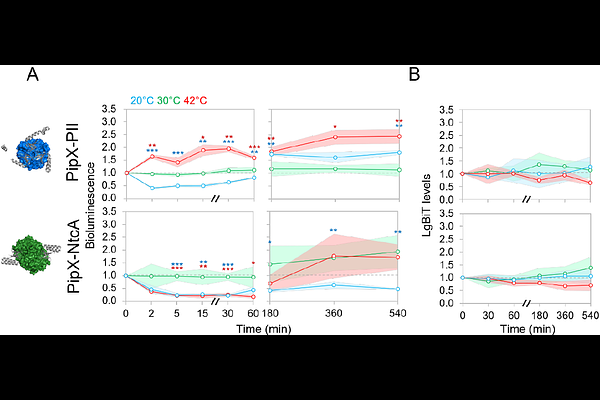Temperature changes are signaled in cyanobacteria through the PipX interaction network

Temperature changes are signaled in cyanobacteria through the PipX interaction network
Llop, A.; Bibak, S.; Mata-Balaguer, T.; Tremino, L.; Fuertes-Garcia, L.; Neira, J. L.; Dixon, R.; Contreras, A.
AbstractCyanobacteria perform oxygenic photosynthesis and have evolved sophisticated mechanisms to adapt their metabolism to challenging environmental changes. Despite their ecological and biotechnological importance, many regulatory proteins are still uncharacterised, and their signalling networks are poorly studied in comparison to other bacterial phyla. Two small proteins, PipX, unique to cyanobacteria, and PII, widespread in bacteria and plants, are the hubs of a protein interaction network involved in carbon/nitrogen homeostasis, energy sensing, translational regulation and growth. Here we exploit the NanoBiT complementation system to demonstrate in real time that temperature affects PipX interactions with its best studied partners: the signal transduction protein PII, the global transcriptional regulator NtcA, and the ribosome-assembly GTPase EngA. While heat shock increased PipX-PII complex formation and impaired PipX-EngA and PipX-NtcA interactions, cold shock resulted in a decrease of all three complexes. Far-UV circular dichroism spectra of isolated PipX suggested the involvement of its C-terminal -helix in the common response to cold shock. However, during longer term acclimatization, each type of complex responded distinctively after up- or downshifts in temperature and PipX-PII and PipX-NtcA interactions were influenced in opposite ways. Altogether the results indicate that PipX is a thermometer of low temperatures, bringing new light to the study of environmental signaling in cyanobacteria. Our results also illustrate the enormous potential of the NanoBiT complementation system to fuel understanding of the mechanisms allowing cyanobacteria to initially respond and/or acclimatize to environmental factors.